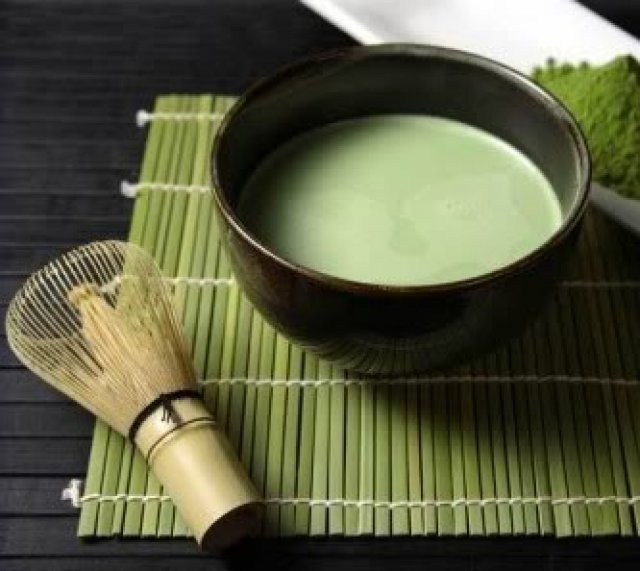Articles
What is Matcha Tea?
Matcha is a green tea that has been created more than 800 years ago. At first, it was used mainly by Buddhist masters and samurai and only recently started to appear in Europe. Fresh tea leaves are milled to a fine powder and the result is remarkable green colour with great taste and exceptional aroma. Matcha tea contains unique catechins and amino acids.


Interesting facts
∗ only 30 grams of matcha can be milled in one hour
∗ 1 cup of matcha is an equivalent of 10 cups of regular infused green tea
∗ by drinking matcha, you consume the entire tea leaf, not just its infusion
∗ the real matcha tea is made only from tencha tea
∗ scientists found out the concentration of antioxidants in matcha tea is about 137 times higher than in regular green tea
∗ L-Theanine in matcha helps calm down organism and supports concentration in general
∗ studies suggest that green tea can help lower the risk of cardiovascular diseases
Matcha Tea contains
♥ amino acids
♥ beta-carotene
♥ catechins
♥ complex polysaccharides
♥ flavonols
♥ saponin
♥ theanine
♥ calcium
♥ chrome
♥ manganese
♥ potassium
♥ selenium
♥ vitamin C, A and E
♥ zinc
And more


∗ lowers physical and mental stress
∗ improves mood and concentration
∗ eliminates bad breath
∗ supports fat oxidation
∗ helps boost up metabolism
∗ supports longevity
How is matcha grown and harvested?
Matcha grows only in shaded fields. The field is shaded about four weeks before harvest. This special technique prevents up to 90 % of sunshine to reach the plant. The plant that is almost completely in dark compensates the lack of sunlight by heightened production of chlorophyll. That makes the leaves rich in amino acids and they get their characteristic emerald colour. You can tell the high quality matcha not only because of its vibrant green colour, but also its fine and sweetish taste.


The harvest takes place in the beginning of may. Most of the tea leaves for matcha are picked by hand. Immediately after the harvest are the leaves taken to a factory. Then starts the long process from crude leaves to a fine powder.
 First, the leaves go through hot steam. The steam stops fermentation process, keeps the leaves fresh and makes sure the leaves keep all their nutrients. Then the leaves are dried. In this process, the leaves‘ weight drops to about one fifth of their original weight. At this point, the tea is called aracha, which can be translated as unrefined tea. Another phase is the selection of aracha. The leaves come in various qualities and that is why they need to be categorised. The tea masters evaluate the colour, quality and taste of the tea.
First, the leaves go through hot steam. The steam stops fermentation process, keeps the leaves fresh and makes sure the leaves keep all their nutrients. Then the leaves are dried. In this process, the leaves‘ weight drops to about one fifth of their original weight. At this point, the tea is called aracha, which can be translated as unrefined tea. Another phase is the selection of aracha. The leaves come in various qualities and that is why they need to be categorised. The tea masters evaluate the colour, quality and taste of the tea.
The final tea is a mix of various sorts of teas and results in consistent quality throughout the year. In the end, the sticks, stems and twigs are removed, so that the only part of the leaf that remains is the pulp of the leaves. The finest and cleanest tea pulp is chopped to the same parts and this type of tea is now called tencha.
Milling of matcha tea
The last step in production of matcha tea is milling which takes place in a completely hygienic places in factories where matcha is milled in granite mills. They mill tencha to a fine powder. And that is how matcha is produced. One grain of matcha is about 5-10 microns, while one micron is one millionth of meter. It is so fine that the powder almost melts in your mouth.

One granite mill can produce only about 30-40 grams of tea per hour, and even in the 21st century, this process can guarantee the tea will maintain its unique colour, taste and aroma throughout the process.
Mixing various grades of tea leaves is one of the most important processes to guarantee the high quality of teas. Production of the tea mix is inevitable when creating different qualities of matcha tea. There is more than 10 different quality grades of matcha that differ from each other in colour, taste, and smell. You can tell the highest grade of matcha by its soothing green colour and fine but also sweetish smell. To make the mix perfect, a real tea master is required and even they need to stick to strict criteria.
Matcha as an antioxidant
Matcha Tea is famous for its antioxidant properties. The chlorophyll colourant that gives matcha its vibrant green colour, helps remove potentially harmful substances from the body.
Natural components in matcha and its benefits
EGCG (epigallocatechin gallate)
is a catechin that helps with fat absorption. It boosts up metabolism and makes excessive fat burning easier.
L-Theanine amino acid
Matcha naturally contains 5 times more L-theanine than regular teas. This amazing amino acid can naturally improve mental alertness and simultaneously keep you naturally relaxed. L-Theanine also improves memory. Tea, Camellia sinensis, is the only plant that contains L-theanine naturally. L-Theanine also stimulates alpha brain waves that are related with calmness and mental ease. It also helps relax the mind and simultaneously provides full concentration. That is why matcha was so popular beverage at monks and samurai. Experiments have shown that theanine has a positive influence on mind and improves memory by raising dopamine levels.

